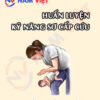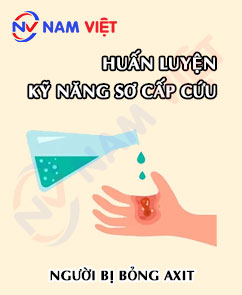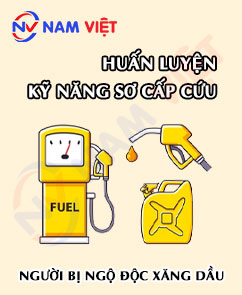First aid training for individuals experiencing a heart attack
500,000 ₫
Note: The above price is calculated per person. Prices may vary depending on the number of participants in the course and market fluctuations. For more accurate pricing, please refer to the price list or contact our consulting staff directly.
Table of Contents
Toggle1. Identifying Heart Attack Victims
a. Cases of heart attacks
A heart attack is an emergency situation that requires immediate intervention to prevent serious consequences. Cases of heart attacks may include:
- Patients with a history of heart disease, especially those over 40 years old
- Patients who have had a stroke, heart failure, or kidney failure
- Patients with high blood pressure, high blood sugar, or high cholesterol
- Patients who smoke or consume alcohol regularly
Common symptoms of a heart attack include:
- Chest pain lasting more than 5 minutes, possibly spreading to the shoulder, left arm, neck, and back
- Shortness of breath, rapid breathing, difficulty speaking, or wheezing
- Abdominal pain, fatigue, nausea, or dizziness
If not treated promptly, a heart attack can result in serious consequences, including death.

b. Signs that someone is about to have a heart attack
Some signs indicating that someone may be at risk of a heart attack or is experiencing one include:
- Chest pain or difficulty breathing
- Pain spreading to both arms, neck, jaw, or back
- Pain between the shoulders or across the back
- Shortness of breath or breathing difficulties
- Fatigue, nausea, or dizziness
- Diabetes or a family history of heart disease
- Other bodily signs such as headaches, fatigue, stomach pain, back pain, or joint pain
If the person has a history of heart disease or is on heart medications, pay close attention to these signs and act promptly if necessary.

c. Golden time for heart attack cases
The golden time is critical for saving a person experiencing a heart attack. Every minute counts and requires immediate action. The golden time for saving a heart attack victim is 0–4 minutes. Prompt treatment during this period greatly increases the survival rate.
After 4 minutes, heart cells begin to suffer damage due to oxygen deprivation. If not treated immediately, these cells die, causing severe damage to the heart and body.
Therefore, if you or someone around you is having a heart attack, call emergency services immediately to receive treatment within the golden time.

2. Overview of First Aid Training for Heart Attack Victims
a. What is a first aid training course?
A first aid training course is a program designed to teach learners basic and advanced first aid skills. The program includes lessons and practical exercises on handling emergencies such as cardiac arrest, respiratory failure, poisoning, injuries, and other urgent situations.
The goal of the course is to equip learners with the skills necessary to respond effectively to emergencies, minimize harm to themselves and others, increase survival chances, and ensure timely medical care.
REGISTER FOR BASIC FIRST AID TRAINING
b. Training duration
Initial first aid training:
- For employees: 4 hours
- For first aid and emergency responders: 16 hours (2 days)
Periodic first aid training:
- For employees: 2 hours
- For first aid and emergency responders: 8 hours (1 day)
c. Course content
- Basic principles of first aid and on-site emergency care
- Wound bandaging (principles, tools, techniques)
- Temporary bleeding control techniques (principles and methods)
- Temporary fracture stabilization techniques (principles and tools)
- Cardiopulmonary resuscitation (recognizing cardiac arrest, airway clearance, breathing support, CPR guidance)
- Burn management (assessing cause and severity, on-site first aid)
- Safe victim transportation with and without stretchers for initial care
- Specific emergency care scenarios:
- Electric shock
- Drowning
- Chemical accidents
- General guidance on first aid kit use
- Practical exercises for all content areas
d. First aid training certificate
Upon completing the course, learners receive a certificate confirming completion of the first aid training program under the Group 2 training framework as specified in Appendix IV, Decree 44/2016/ND-CP. The certificate is valid for 1 year.


3. Essential Tools for a First Aid Kit in Case of a Heart Attack
Having a complete first aid kit in case of a heart attack can help save the victim’s life. Essential items include:
- Blood pressure monitor: Used to measure the victim’s blood pressure.
- Heart rate monitor: Used to measure the victim’s heart rate.
- Nitroglycerin: Helps relieve chest pain by dilating blood vessels and increasing blood flow to the heart.
- Aspirin: Acts as a pain reliever and reduces the risk of stroke. If the victim has not been diagnosed with a heart attack, they may be asked to take aspirin.
- At least one small rescue ventilator: Can be used to save the victim in case of sudden cardiac arrest.
- Insulation filter device: Necessary if the victim is using devices such as a pacemaker or cardiac assist device, to isolate the rescuer from the device.
- Thermal blanket: Can be used to keep the victim warm if they show signs of shock.
- Adhesive electrodes: Can be used to help restart the heart if the victim suddenly stops beating.
- Rescue breathing bag: Used to supply oxygen to the victim’s lungs if they stop breathing.
- ECG machine: Used to measure the heart’s electrical signals and quickly diagnose a heart attack.
Remember, if you lack experience or first aid training, do not use these tools. Contact the nearest medical rescue team for assistance.
REGISTER FOR BASIC FIRST AID TRAINING
4. First Aid Procedure for Heart Attack Victims
The most important action during a heart attack is to call emergency services immediately. If you are not a medical professional, ensure that you call 115 or emergency rescue within the first 5 minutes of symptom onset. While waiting for medical help, you can take the following steps:
- Help the victim rest: Ask the victim to rest and ensure their safety.
- Administer Nitroglycerin: If the victim has been previously diagnosed and prescribed Nitroglycerin, help them take it.
- Make the victim comfortable: Loosen tight clothing to ease breathing and comfort.
- Check respiration: If the victim stops breathing or has difficulty, begin CPR until help arrives.
- Provide oxygen: If an oxygen cylinder is available in the first aid kit, supply oxygen to the victim.
5. Benefits of First Aid Training
First aid training provides numerous important benefits for individuals and the community:
- Saving lives in dangerous situations: First aid skills allow trainees to save people at risk, such as cardiac arrest, respiratory arrest, poisoning, injuries, and other emergencies.
- Helping others learn first aid: Trained individuals can share knowledge and experience with others, enabling the community to protect itself and reduce fatalities in emergency situations.
- Reducing waiting time for rescue: Trained first aiders can manage emergencies on-site, minimizing the wait for rescue teams.
- Enhancing response and reducing stress in emergencies: Training improves the ability to react quickly and accurately, reducing pressure and anxiety while awaiting help.
- Increasing survival rates and reducing fatalities: Timely and proper first aid increases survival chances and reduces complications or deaths.

6. First Aid Training Capacity of An Toan Nam Viet
An Toan Nam Viet is a reputable and high-quality first aid training center in Vietnam. Training sessions are conducted continuously at workshops, factories, and construction sites nationwide (all 63 provinces of Vietnam).
REGISTER FOR BASIC FIRST AID TRAINING
Training Certification
- An Toan Nam Viet has been inspected and certified by the Department of Safety under the Ministry of Labor – Invalids and Social Affairs for occupational safety training. The Group 2 training program includes first aid skills, further strengthening our capacity in first aid training.

Training Materials and Lectures
- Before being used in first aid courses, training materials are reviewed to ensure accuracy and effectiveness.
- Instructor methods follow An Toan Nam Viet standards, developed by experts in first aid training to maximize knowledge retention.
Facilities
- Controlling classroom factors enhances teaching efficiency and learning outcomes.
- Our training facilities provide spacious classrooms meeting standards for area, lighting, and equipment.
7. Nationwide First Aid Training Centers
An Toan Nam Viet is a reputable and professional organization for first aid training in Vietnam. With experienced instructors, modern equipment, and high-quality programs, it has become an ideal destination for those interested in protecting their own and the community’s health and life.
By participating in courses at An Toan Nam Viet, you will learn basic and advanced first aid skills, from CPR for cardiac arrest, respiratory arrest, poisoning, injuries, to handling other emergencies. Programs are flexible and suitable for all learners, including adults, children, medical staff, rescue personnel, and the general public.
An Toan Nam Viet’s first aid training not only teaches essential life-saving skills but also fosters awareness to protect your life and the health of those around you. Training by experienced instructors ensures confidence and readiness for any emergency situation.
Register for first aid courses at An Toan Nam Viet to protect your life, health, and the community.
1 review for First aid training for individuals experiencing a heart attack
No comments yet












maituyet.cuong12
Good first aid training center! Satisfied